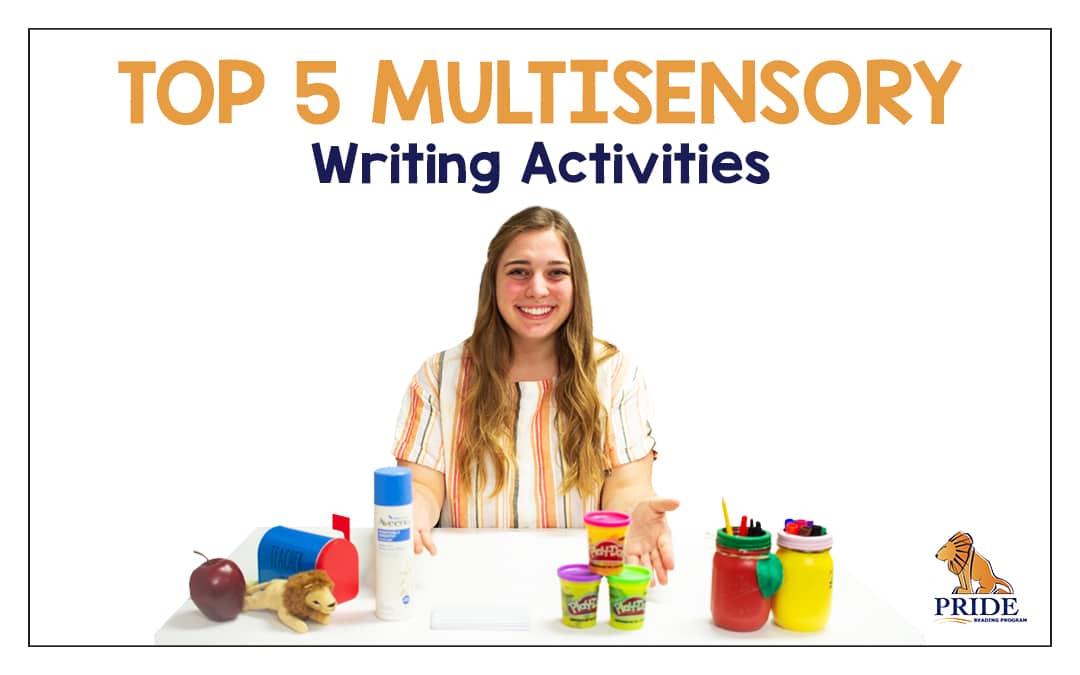Learning to write doesn’t have to be boring or difficult. You can make your writing lessons fun and engaging by using multisensory activities. For children that struggle with writing or have been diagnosed with dysgraphia, a multisensory teaching method is the most effective way for them to learn. This includes seeing it (visual), hearing it (auditory), and moving with it (kinesthetic). On today’s post I came up with my Top 5 Multisensory Writing Activities that I want to share with you today.
Here’s a Literacy Lunch video that shows you exactly what each of these activities looks like:
1. Use Playdough
Roll out the play dough so it becomes a flat surface. From here you can get really creative.
Using a pencil, chopstick, or even a golf tee, have your child write letters, words, or sentences into the surface of the play dough. For younger children, you can place letter cards in front of them for reference. For older students, you can dictate sight words, spelling words, and sentences that they can write into the play dough surface.
Letter tiles also work great with play dough. You can have your child stick letter tiles into the play dough using it like a holding stand.
You can use letter magnets and letter stamps onto the surface of the play dough too.
2. Use Body Language
When writing on lined paper, some letters stay inside the lines and some letters dip down below the lines. To help your child remember which letters go where on the lines, this multisensory writing activity will really help.
Write a word on the board, for example the word tag. Ask your child to write the word tag with his or her body.
For tall letters like t have your child jump high. For medium size letters like a have your child stand in place. For letters that dip down below the lines like g have your child crouch down.
This activity never gets old! Spread shaving cream out on a flat surface or tray and then let your child write out the letters or words or sentences. This is really messy but oh so fun! Change it up by using pudding or whipped cream. You can also put shaving cream on a mirror in the bathroom – makes cleaning up a lot easier.
3. Use Highlighter
Highlighters are another great multisensory writing tool you can try out. Just write out the letters you want your child to practice in highlighter, then have your child trace over them with a dark pen or marker. You can also switch it up and have your child highlight over letters that you’ve written in a dark color.
4. Sky Writing
When using the sky writing, have your child will stretch his or her arm out as far as it can go. The child then uses their pointer and middle finger to form the letters in the air at least two feet high.
This whole body movement helps your child cement the idea of how each letter is formed, both physically, visually, and audibly. This whole body experience uses muscle memory to store the information into the brain which is used later on when writing with a pencil on paper.
5. Use Shaving Cream
This activity never gets old! Spread shaving cream out on a flat surface or tray and then let your child write out the letters or words or sentences. This is really messy but oh so fun! Change it up by using pudding or whipped cream. You can also put shaving cream on a mirror in the bathroom – makes cleaning up a lot easier.
Thank you so much for reading my post today! If you enjoyed this list of top 5 multisensory writing activities, you might also enjoy reading my previous posts:
My Favorite Sight Word Activities
Please don’t leave without checking out the PRIDE Reading Program. A curriculum that is used by teachers, tutors, and homeschooling parents worldwide with great success.



